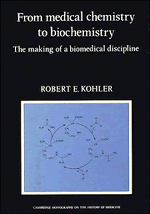Book contents
- Frontmatter
- Contents
- 1 Introduction: On discipline history
- 2 Physiological chemistry in Germany, 1840–1900
- 3 Physiology and British biochemists, 1890–1920
- 4 General biochemistry: the Cambridge school
- 5 European ideals and American realities, 1870–1900
- 6 The reform of medical education in America
- 7 From medical chemistry to biochemistry: the emergence of a discipline
- 8 Unity in diversity: the American Society of Biological Chemists
- 9 The clinical connection: biochemistry as applied science
- 10 Chemical ideals and biochemical practice
- 11 Biological programs
- 12 Epilogue: Toward a molecular biology?
- Location of archival sources and abbreviations
- Notes
- Index
4 - General biochemistry: the Cambridge school
Published online by Cambridge University Press: 07 October 2011
- Frontmatter
- Contents
- 1 Introduction: On discipline history
- 2 Physiological chemistry in Germany, 1840–1900
- 3 Physiology and British biochemists, 1890–1920
- 4 General biochemistry: the Cambridge school
- 5 European ideals and American realities, 1870–1900
- 6 The reform of medical education in America
- 7 From medical chemistry to biochemistry: the emergence of a discipline
- 8 Unity in diversity: the American Society of Biological Chemists
- 9 The clinical connection: biochemistry as applied science
- 10 Chemical ideals and biochemical practice
- 11 Biological programs
- 12 Epilogue: Toward a molecular biology?
- Location of archival sources and abbreviations
- Notes
- Index
Summary
“General biochemistry” differed from “chemical physiology” in both scope and emphasis. It was a broadly biological program, taking as its domain all forms of life: microbes, plants, invertebrates, and higher animals. It was concerned ultimately with fundamental processes – growth, development, energy transformation, and biochemical control – rather than special problems of human physiology and pathology. General biochemists looked to more varied constituencies: zoologists, botanists, microbiologists, as well as physiologists and pathologists. This broad conception of biochemistry was both an intellectual design and a political strategy for discipline building. Breadth and diverse audiences legitimated independence from physiology and provided access to wider institutional support systems.
General biochemistry required a broader base of support than that provided by service roles in physiology and medicine. Consequently, it was limited prior to 1945 to a few institutions: F. G. Hopkins's school, Rudolf Peters's at Oxford (an offshoot of Cambridge), David Keilin's group at the Molteno Institute, and a few small research units. Endowment and favored connections to external patrons of basic research freed these groups from dependence on a single source of support and recruits, namely medical teaching. An undergraduate degree program in biochemistry gave Hopkins an unusually large and diverse pool of recruits. The broader programmatic missions of government councils and private foundations found expression in the researches they supported. Just as chemical physiology was congruent with its limited basis in medical physiology, independence from service roles facilitated more general, avant-garde research.
- Type
- Chapter
- Information
- From Medical Chemistry to BiochemistryThe Making of a Biomedical Discipline, pp. 73 - 92Publisher: Cambridge University PressPrint publication year: 1982

